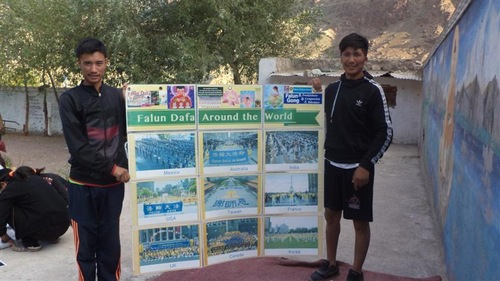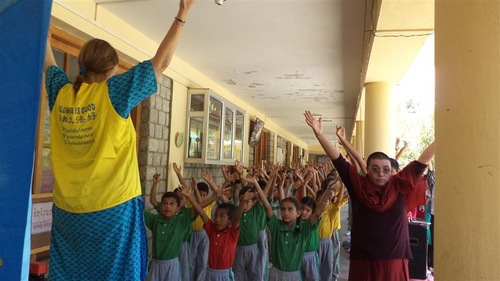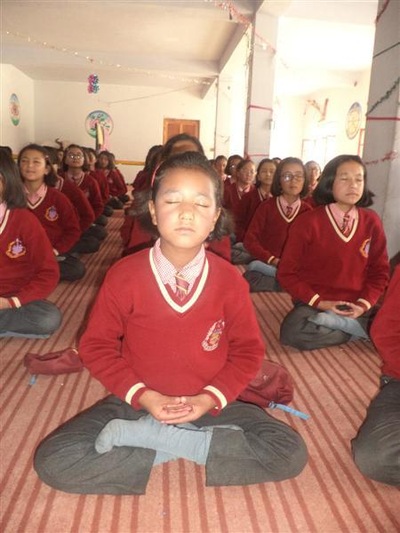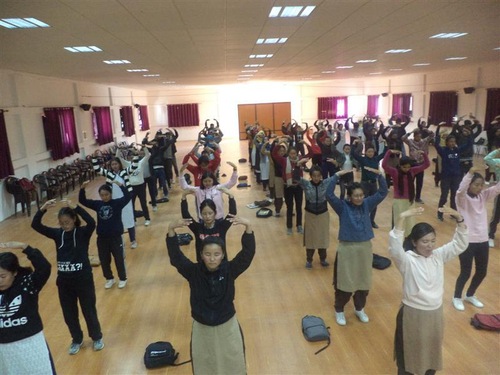(Minghui.org) Ladakh is the northernmost part of India, situated close to Pakistan and sharing borders with Tibet and China. It was once a remote area, a “pure land” where people lived simple and happy lives. They were self-sufficient and in total harmony with their culture, religion, and environment. Over the last few summers, however, the area has been overrun by tourists from other parts of India and all over the world.
Some locals say that this rapid development is like going from “bungbu,” a local word for donkey, to “Boeing,” the airplane company—without any steps in between. The effects can be seen and felt everywhere, especially in the main town of Leh, where guesthouses, shops, and hotels have sprung up everywhere and expanded endlessly. More and more cars and motorbikes have jammed the roads. Accompanying this growth is a rapid loss of traditions and culture, and most disturbingly, the warping and loss of values.
A Falun Dafa practitioner who has visited Ladakh in the summer months since 1991 describes these changes as “heartbreaking.” Every year she thinks that she’ll never come back to Ladakh—only to return the following year yet once again.
This year, the practitioner arrived at the end of May and stayed until the end of October, making these five-plus months her longest stay to date. She introduced Falun Dafa and taught the Dafa exercises in schools and towns throughout the area, oftentimes reconnecting with those who'd learned about and come to cherish Dafa from her many prior visits.
Schools for All Ages Embrace Falun Dafa Meditation
In total, the practitioner visited 19 schools and one college: five of them in Leh, six a little outside of Leh, and eight in villages several hours away. She'd visited nine of these places previously.
The students ranged from three-year-olds to college students. They and their teachers said they felt comfortable, peaceful, and happy after the Falun Dafa sessions, and there was always a pin-drop silence during the fifth exercise, the sitting meditation.
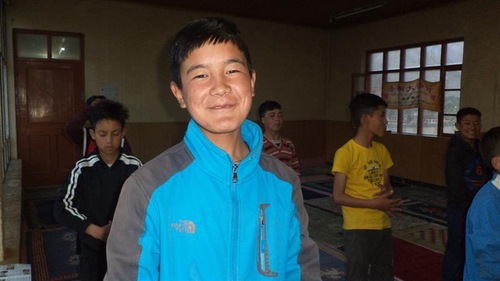 A joyful smile during the Falun Dafa instruction session in a boys’ boarding school
A joyful smile during the Falun Dafa instruction session in a boys’ boarding school
Some of the older children mentioned that their stress and worries had totally disappeared after doing the exercises. In some schools that hosted the Falun Dafa sessions for the very first time, teachers and students remarked, “One time is not enough. We want to do Falun Dafa again and again.”
Meanwhile, in some schools where Falun Dafa sessions had been held in previous years, these events were closer to a celebration, sacred and pure.
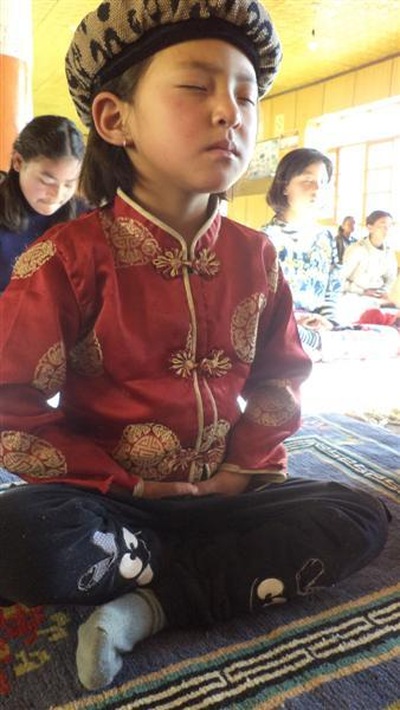 This little girl, unlike others who attended casually dressed, was wearing a special jacket and cap. She attended two Falun Dafa sessions at a girls’ boarding school in a row. Her demeanor stood out as she stayed quiet and fully absorbed throughout both long classes.
This little girl, unlike others who attended casually dressed, was wearing a special jacket and cap. She attended two Falun Dafa sessions at a girls’ boarding school in a row. Her demeanor stood out as she stayed quiet and fully absorbed throughout both long classes.
A few teachers wondered whether the youngest children could practice and understand the Dafa exercises, but they were pleasantly surprised to see them quiet, absorbed, and fully concentrated, at times even more so than the older children. Even though some of the youngest ones needed help putting on their shoes, they seem naturally connected to Truthfulness, Compassion, and Forbearance, especially once they close their eyes and hear the serene exercise music.
Expanding Horizons
Toward the end of each session, the practitioner exhibited posters of paintings by Dafa practitioners, such as “Homeless,” “Why?” “Come Back Daddy,” “Unmovable,” and others, which depict the persecution of Falun Dafa in China and the spirit of practitioners who hold firm to their faith.
The practitioner explained each painting according to the children’s level of comprehension. None could understand or believe why such a peaceful practice would be so brutally persecuted.
In addition, the students were shown posters of Falun Dafa around the world, a painting of a baby boy sitting in meditation, and other artworks. A red and yellow banner with the words “Falun Dafa is Good” in Chinese and English was also displayed.
Sometimes, in smaller schools, short films were shown on an iPad, such as the short video from 2011 of local children singing “Falun Dafa Hao” (“Falun Dafa is Good”), which quickly inspires children to sing and clap along. Footage of the Tian Guo Marching Band fascinates the students as well.
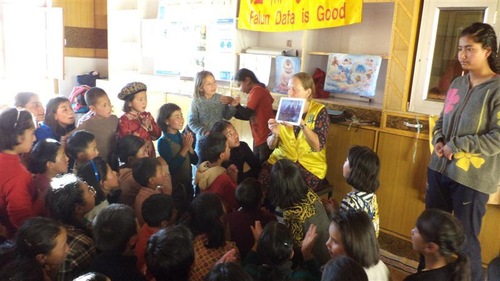 Children at a girls’ boarding school watch a video on an iPad that shows other children singing “Falun Dafa Hao.”
Children at a girls’ boarding school watch a video on an iPad that shows other children singing “Falun Dafa Hao.”
 Three boys in three different schools each had a fractured arm that was in a plaster cast. Nonetheless, they did the exercises along with the other children. One boy’s cast says “Hero” on it.
Three boys in three different schools each had a fractured arm that was in a plaster cast. Nonetheless, they did the exercises along with the other children. One boy’s cast says “Hero” on it.
The last school the practitioner visited was the smallest one, consisting of nine aspiring young lamas (monks). A little boy said that their lama teacher had given them Falun Dafa flyers and bookmarks, which he found to be so beautiful and good that he was inspired to do the Dafa exercises by himself.
Throughout her journey, the practitioner observed that children from more remote areas often displayed a higher degree of innocence and purity than those from the main town.
Letters of Appreciation
Principals and teachers often write letters to the practitioner to express their gratitude for the Falun Dafa sessions. This year’s letters differed greatly from those in previous years, reflecting the town’s changing values amid its growth.
One letter reads:
“Today schools are becoming increasingly complex as they mirror the current socio-economic landscape driven by rapid demographic, technological and cultural changes, as well as by changing family structures, demands and values. As a result, in many schools children now seem to be quite unhappy, perhaps due to too much pressure, high expectations, and an overemphasis on academics and competition.
“Keeping this in view, [name of the school] has taken on a significant initiative to educate the mind and heart of the students on Truthfulness, Compassion, and Forbearance in order to live a happy, truthful and tolerant life,” the letter continued.
After expressing a “deep sense of gratitude and appreciation” toward the practitioner, the letter went on to say, “We have received overwhelming positive feedback from the students about the benefits of the workshop. It has improved tolerance level, strengthens connections with others through a compassionate heart, and realized the significance of living a truthful life. The students thoroughly enjoyed the workshops and actively participated in the learning through an excellent facilitator, [name of the practitioner].”
It concludes by wishing the practitioner “the best of everything” as she plans to create an ecosystem of Truthfulness, Compassion, and Forbearance in schools across different countries.
Another letter highlights her “voluntary service to spread the message of ‘Truth, Compassion, and Forbearance.’” It continues, “The children showed keen interest in learning the exercises through various techniques. It has tremendous power to improve the health and character of the children. I have observed good changes in the behavior of the children after the workshop.”
A third letter honors the practitioner’s “remarkable contribution” to the school, how she talked about “the three main characteristics which we must have in our life, i.e. Truthfulness, Compassion, and Forbearance,” and how these values helped the students and staff to “harmonize the body and lead to a clear and peaceful mind.”
According to the letter, one student said that Dafa “makes me more compassionate in my life.” Another student mentioned having “attained peace by doing Falun Dafa.” A third student recalled that Falun Dafa “teaches us about real facts of life like Truthfulness, Compassion, and Forbearance.”
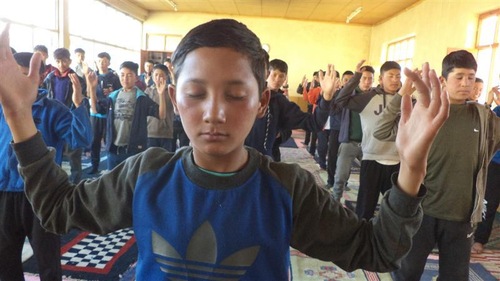 Exercise session in a boys’ boarding school
Exercise session in a boys’ boarding school
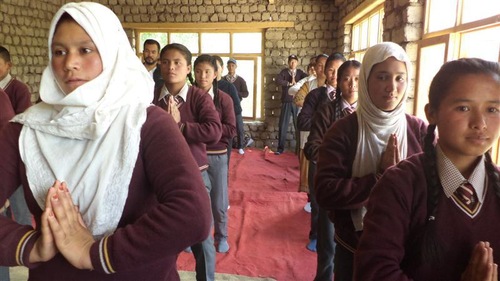 This session was held in a girls’ school for grades 9 to 12. Muslim girls mostly wear white headscarves.
This session was held in a girls’ school for grades 9 to 12. Muslim girls mostly wear white headscarves.
 This young boy observed the painting of the baby boy, one and a half years old, and imitated him perfectly. He sat motionless with his eyes closed for a long time while the practitioner explained the fifth exercise and most other children were restless.
This young boy observed the painting of the baby boy, one and a half years old, and imitated him perfectly. He sat motionless with his eyes closed for a long time while the practitioner explained the fifth exercise and most other children were restless.
Category: Clarifying the Truth





